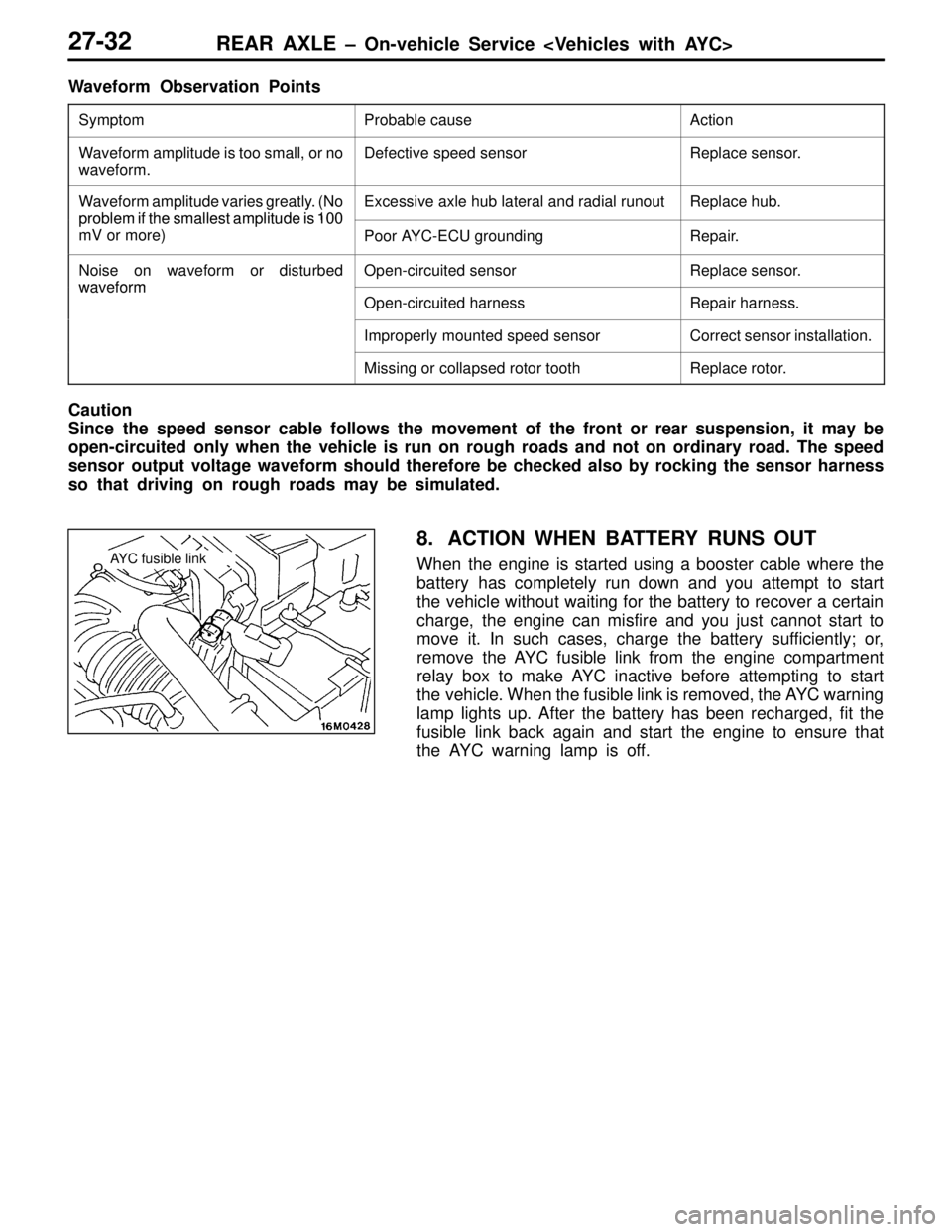Page 210 of 396

REAR AXLE – Troubleshooting 27-24
7. CHECK AT AYC-ECU TERMINALS
7-1 TERMINAL VOLTAGE LISTING
(1) The voltage is to be measured across each terminal and ground terminal.
(2) Fig. below shows the arrangement of the terminals.
Terminal
No.Check itemCheck requirementNormally
1Lateral acceleration sensorIgnition switch: ON2.4 – 2.6 V
(horizontal position)
2Longitudinal acceleration
sensor ground
Lateral acceleration sensor
groundAt all times0 V
3Longitudinal acceleration
sensorIgnition switch: ON2.4 – 2.6 V
(horizontal position)
4Steer sensor (ST-2)Engine: Idle speed
Turn steering wheel slowly.0 V ↔ approx. 3 V
flashing
5Steer sensor (ST-1)Engine: Idle speed
Turn steering wheel slowly.0 V ↔ approx. 3 V
flashing
6*1FR wheel speedVehicle stationary1 V or less
Forward vehicle slowly.0 – 5 V
7*1FL wheel speedVehicle stationary1 V or less
Forward vehicle slowly.0 – 5 V
8*1RR wheel speedVehicle stationary1 V or less
Forward vehicle slowly.0 – 5 V
9*1FL wheel speedVehicle stationary1 V or less
Forward vehicle slowly.0 – 5 V
10Diagnosis selection inputBattery voltage
11Stop lamp switchIgnition switch:
ON
Stop lamp switch: ONBattery voltage
ON
Stop lamp switch: OFF1 V or less
12*1ABS monitorWhen ABS monitor is activatedBattery voltage
When ABS monitor is deactivated1 V or less
17Steer sensor (ST-N)Engine:
Idle speed
Steering wheel: Neutral position0.5 V or less
Idle speed
Steering wheel: Turned 90� from
neutral position2.5 – 3.5 V
Page 211 of 396

REAR AXLE – Troubleshooting 27-25
Terminal
No.Normally Check requirement Check item
18TPSIgnition switch:
ON
Accelerator pedal: Fully closed0.3 – 1.0 V
ON
Accelerator pedal: Fully open4.5 – 5.0 V
23Diagnosis data input/output1 V or less
24Idle position switchIgnition switch:
ON
Accelerator pedal: Fully closed2 V or less
ON
Accelerator pedal: Fully open4.5 – 5.0 V
25Accumulator pressure
switchIgnition switch:
ONAccumulator internal pressure:
Low2 V or less
Accumulator internal pressure:
HighBattery voltage
26ECU groundAt all times0 V
31AYC-ECU power supplyIgnition switch: ONBattery voltage
Ignition switch: OFF0 V
35AYC motor relayIgnition switch:
ON
When motor is energizedBattery voltage
ON
When motor is deenergized2 V or less
36AYC warning lampIgnition switch:
ON
When lamp is OFFBattery voltage
ON
When lamp is ON2 V or less
37Directional control valve
(right)
Ignition switch:
ON
Right clutch: ONBattery voltage
(right)ON
Right clutch: OFF0 V
38Proportioning valveIgnition switch:
ONAYC-ON0 V to battery volt-
age
AYC-OFF0 V
39ECU backup power supplyAt all timesBattery voltage
45Directional control valve
(left)
Ignition switch:
ON
Left clutch: ONBattery voltage
(left)ON
Left clutch: OFF0 V
46ECU groundAt all times0 V
NOTE
*1: Indicates the vehicles with ABS.
Page 212 of 396

REAR AXLE – Troubleshooting 27-26
7-2 LISTING OF RESISTANCE AND CONTINUITY ACROSS CONNECTOR TERMINALS ON
HARNESS SIDE
(1) Measure the resistance and check for continuity with the ignition switch in the “OFF” position and
AYC-ECU connector disconnected.
(2) Measure the resistance and check for continuity across terminals listed below.
(3) Fig. below shows the arrangement of terminals.
Terminal No.Signal nameNormally
2 – body groundLongitudinal acceleration sensor ground, lateral acceleration sensor groundConducting
26 – body groundECU groundConducting
35 – body groundAYC motor relayConducting
37 – body groundDirectional control valve (right)15.4 – 16.4 Ω
38 – body groundProportioning valve3.4 – 4.0 Ω
45 – body groundDirectional control valve (left)15.4 – 16.4 Ω
46 – body groundECU groundConducting
6 – 19*2Speed sensor (front, RH)1.4 – 1.8 Ω
7 – 20*2Speed sensor (front, LH)1.4 – 1.8 Ω
8 – 21*2Speed sensor (rear, RH)1.4 – 1.8 Ω
9 – 22*2Speed sensor (rear, LH)1.4 – 1.8 Ω
NOTE
*2: Indicates the vehicles without ABS.
Page 217 of 396

REAR AXLE – On-vehicle Service 27-31
7. SPEED SENSOR OUTPUT VOLTAGE
MEASUREMENT
ABS>
(1) Lift up the vehicle and release the parking brake.
(2) Disconnect the AYC-ECU harness connector and take
measurements on the harness side connector.
Caution
Insert the probe from the harness side with the double
lock of the connector unlocked. Inserting it to the
terminal side could result in poor contact.
(3) Turn the wheel to be tested at about 1/2 to one
revolution/sec. and check for the output voltage using
a circuit tester (AC mV range) or oscilloscope.
Terminal nos.
Front LHFront RHRear LHRear RH
7698
20192221
Output voltage:
When circuit tester is used: 70 mV or more
When oscilloscope is used: 200 mVp-p or more
(4) If the output voltage is lower than the above value, it
is probably attributable to the following faults. Check or
replace the speed sensor as necessary.
�Excessive clearance between the pole piece and rotor
of the speed sensor
�Defective speed sensor
Waveform Check Using Oscilloscope
Check the harness and connector of the speed sensor for
connection. Then, use an oscilloscope to check for output
voltage waveform of each speed sensor as follows.
Start the engine and monitor the sensor by turning the wheel;
for a driving wheel, let it turn by shifting into the 1st gear
and for a driven wheel turn it manually at a constant speed.
NOTE
(1) Waveform may be observed by actually running the
vehicle.
(2) The output voltage is low when the wheel speed remains
low and builds up as the wheel speed increases.
AYC-ECU connector harness side
When turned manually
At idle (5 to 6 km/h)
1st gear
Page 218 of 396

REAR AXLE – On-vehicle Service 27-32
Waveform Observation Points
SymptomProbable causeAction
Waveform amplitude is too small, or no
waveform.Defective speed sensorReplace sensor.
Waveform amplitude varies greatly. (No
problem ifthe smallest amplitude is 100
Excessive axle hub lateral and radial runoutReplace hub.
problem if the smallest amplitude is 100
mV or more)Poor AYC-ECU groundingRepair.
Noise on waveform or disturbed
waveform
Open-circuited sensorReplace sensor.
waveform
Open-circuited harnessRepair harness.
Improperly mounted speed sensorCorrect sensor installation.
Missing or collapsed rotor toothReplace rotor.
Caution
Since the speed sensor cable follows the movement of the front or rear suspension, it may be
open-circuited only when the vehicle is run on rough roads and not on ordinary road. The speed
sensor output voltage waveform should therefore be checked also by rocking the sensor harness
so that driving on rough roads may be simulated.
8. ACTION WHEN BATTERY RUNS OUT
When the engine is started using a booster cable where the
battery has completely run down and you attempt to start
the vehicle without waiting for the battery to recover a certain
charge, the engine can misfire and you just cannot start to
move it. In such cases, charge the battery sufficiently; or,
remove the AYC fusible link from the engine compartment
relay box to make AYC inactive before attempting to start
the vehicle. When the fusible link is removed, the AYC warning
lamp lights up. After the battery has been recharged, fit the
fusible link back again and start the engine to ensure that
the AYC warning lamp is off.AYC fusible link
Page 219 of 396
REAR AXLE – Rear Hub Assembly27-33
REAR HUB ASSEMBLY
REMOVAL AND INSTALLATION
12
3
4
56 7
8
Unit: Nm {kgf�m}
118 {12.0}
74 – 88
{7.5 – 9.0} 49 – 59
{5.0 – 6.0}196 – 255
{20.0 – 26.0}
Removal steps
�A�1. Caliper assembly
2. Brake disc
3. Shoe & lining assembly
(Refer to GROUP 36 – Parking
Brake.)
4. Clip
5. Parking brake cable connection�B��A�6. Drive shaft nut
�C�7. Rear hub assembly
8. Backing plate
Caution
Do not disassemble the rear hub assembly.
REMOVAL SERVICE POINTS
�A�CALIPER ASSEMBLY REMOVAL
Secure the removed caliper assembly with a wire so that
it will not fall.
�B�DRIVE SHAFT NUT REMOVAL
�C�REAR HUB ASSEMBLY REMOVAL
(1) Using the special tool, remove the drive shaft from the
rear hub assembly.
(2) Remove the mounting bolts and remove the rear hub
assembly from the knuckle.
MB990767
MB990244 (3) MB990767
MB990242MB991354
Page 220 of 396

REAR AXLE – Rear Hub Assembly27-34
INSTALLATION SERVICE POINT
�A�DRIVE SHAFT NUT INSTALLATION
(1) Install the washer on the drive shaft in the direction shown
on the left.
(2) Using the special tool, tighten the drive shaft nut to the
specified torque.
Caution
Before torquing the drive shaft nut to specification,
do not apply vehicle weight to the wheel bearing.
(3) If, at this time, the split pin holes are not aligned, tighten
the nut further (within 255 Nm {26.0 kgf�m}), insert the
split pin in the first matching holes, and bend it securely.
INSPECTION
1. REAR WHEEL BEARING ROTATION STARTING
TORQUE
(1) Install the special tool to the rear hub assembly and tighten
it to the specified torque.
(2) Using the special tool, measure the wheel bearing rotation
starting torque.
Limit: 1.0 Nm {10.5 kgf�cm}
(3) The wheel bearing starting torque should be within the
limit and the hub should be free of binding or rough motion
when turned.
2. WHEEL BEARING AXIAL PLAY CHECK
(1) Check the wheel bearing for axial play.
Limit: 0.05 mm
(2) If the specified torquing range (196 to 255 Nm {20.0
to 26.0 kgf�m}) does not bring the wheel bearing axial
play into the limit, replace the rear hub assembly.
Washer
MB990767196 – 255 Nm
{20.0 – 26.0 kfg�m}
MB990326 MB991000
(MB990998)
Wood block 196 – 255 Nm
{20.0 – 26.0 kfg�m} MB991017
Wood block
Wood block
MB991017
Page 223 of 396
REAR AXLE – Drive Shaft27-37
REMOVAL SERVICE POINTS
�A�DRIVE SHAFT NUT REMOVAL
Caution
Do not apply the vehicle weight to the wheel bearing
with the drive shaft nut loosened.
�B�DRIVE SHAFT REMOVAL
(1) Using the special tool, drive the drive shaft out of the
hub.
(2) Apply a lever to the protrusion of the drive shaft and
remove the drive shaft from the differential carrier.
Caution
(1) Be sure to remove the drive shaft from the
differential side using a lever. Removing it from
the BJ side could damage the parts.
(2) Do not apply the vehicle weight to the wheel
bearing with the drive shaft removed. If it is
unavoidable to apply the weight for reasons of
moving the vehicle, use the special tool to
temporarily secure it in position.
(3) To prevent entry of foreign matter into the
differential carrier, use the special tool as a cover.
MB990767
MB990244 (3) MB990767
MB990242 MB991354
MB991000
(MB990998)
MB991017
MB991460